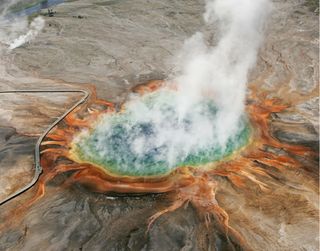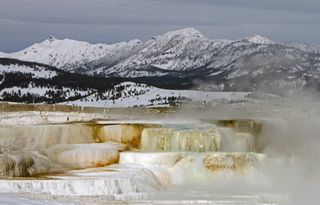
What Makes Yellowstone's Hot Springs So Colorful?

The iconic image of Yellowstone is an expansive spring with rainbow-like colors radiating from its center, dominated by a fiery orange hue at its edges. Though these dazzlingly painted hot springs seem fit only for picture books, their colors come from very real, and very earthly, microscopic creatures.
Hiding out in the park's hot springs — where temperatures are high enough to blister your skin and as acidic as liquid in a car battery — are heat-loving microbes. And they're thriving. Where you see rings of color, there are, most of the time, rings of different bacteria, each group adapted to the conditions, such as temperature and pH (how acidic a solution is) of their environments, according to the National Park Service.
Take Grand Prismatic Spring, the park's largest hot spring and the one whose rainbow colors make it so iconic. Its diverse hues can be explained by the ways temperature and light affect microbes. [Rainbow Basin: Photos of Yellowstone's Colorful Grand Prismatic Hot Spring]
Aquamarine to dark blue
Let's start at the center of the hot spring, a brilliant aquamarine. The center of the spring is just above its underground water source, and it's where temperatures are the highest — up to 189 degrees Fahrenheit (or 87 degrees Celsius), Smithsonian reported. There, the water is too hot for most microbial growth. It is, therefore, mostly clear water. The center of the spring is blue for the same reason that the sky is blue: When sunlight hits the water's surface, the light scatters, and blue light scatters the most, meaning that's what reflects back to your eyes.
The hot spring's water cools as it spreads farther from the source, and that, in turn, changes the bacteria that can live in it.
Yellow
Moving outward from the blue center, the first ring of color is yellow, thanks to cyanobacteria called Synechococcus. The temperature of this yellow band is about 165 degrees F (74 degrees C). Under other conditions, these bacteria might create a blue-green hue thanks to chlorophyll, a green pigment they produce that allows them to photosynthesize, or build carbohydrates and oxygen gas out of water, carbon dioxide, and energy from the sun, during the day, according to the National Park Service. (At night, they switch to another mode of energy production, fermentation.) But the sunlight hitting the prismatic spring is so intense that the bacteria produce another kind of pigment called carotenoids, which act as sunscreen for the bacteria, according to the Smithsonian magazine. Carotenoids, which are also found in carrots, are orange and thus turn the normally green Synechococcus bacteria a more jaundiced shade.
Orange
In the orange band, which is a cooler 149 degrees F (65 degrees C), you'd find not only Synechococcus bacteria but also Chloroflexus bacteria, which also contain both chlorophyll, for photosynthesis, and the carrot-colored carotenoids. Two other bacteria that produce orange-colored mats, Phormidium and Oscillatoria, which are both found in Mammoth hot springs within Yellowstone.
Sign up for the Live Science daily newsletter now
Get the world’s most fascinating discoveries delivered straight to your inbox.

Red-brown to burgundy
As you get farther from the center of the hot spring, the temperatures get lower and there is a greater diversity of microbes that can survive there, Smithsonian's Natasha Geiling reported. The spring's outermost layer, at 131 degrees Fahrenheit (55 degrees Celsius), is a red-brown or burgundy color. Another carotenoid-carrying microbe also comes into play at this temperature: Deinococcus-Thermus Thermus creates "bright red or orange streamers," according to a blog by the American Geophysical Union (AGU). For instance, the Lower Geyser basin in Yellowstone has a reddish hue due to this bacteria.
Humans change a spring's colors
Researchers have gone a step further than showing that environmental features favor microbes that produce certain colors. As they reported in a 2015 paper published in the journal Applied Optics, they created a mathematical model to explain the colors within the springs. Consistent with what is seen at the Grand Prismatic Basin, the researchers, from Montana State University in the U.S. and Brandenburg University of Applied Sciences in Germany, found that in deep water, the color resulted mostly from the light's interaction (scattering, absorption) with the water itself, whereas in the shallow areas, the color came from the reflection of light from microbial mats, whose composition depended highly on temperature.
They also reported that humans might have influenced the colors of Yellowstone's geothermal features. In the past, the temperatures of Morning Glory Pool were significantly higher, and its color was a deep blue, they reported. As trash accumulated in the pool, somewhat clogging the vent, its temperature cooled, allowing for microbial growth and giving rise to orange-yellow microbial mats that give the pool its psychedelic appearance, according to a statement from The Optical Society.
So don't take the chromatic beauty of Yellowstone's hot springs for granted. They depend on microbial life, and as the Applied Optics study indicated, the bacterial composition of that microbial life could depend on us.
Original article on Live Science.

Ashley P. Taylor is a writer based in Brooklyn, New York. As a science writer, she focuses on molecular biology and health, though she enjoys learning about experiments of all kinds. Ashley's work has appeared in Live Science, The New York Times blogs, The Scientist, Yale Medicine and PopularMechanics.com. Ashley studied biology at Oberlin College, worked in several labs and earned a master's degree in science journalism from New York University's Science, Health and Environmental Reporting Program.
Most Popular



